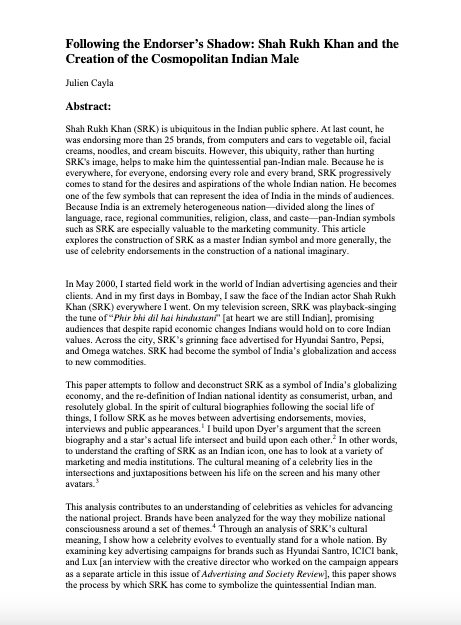Consumer Culture in Asia

Cayla, Julien, et al. "From social feeds to market fields: How influencer stories drive market innovation." International Journal of Research in Marketing (2025).
Abstract
One post at a time, social media influencers are transforming markets. From beauty to technology, they are changing the way consumers form opinions and engage with the mar-ketplace. Yet, past marketing scholarship has predominantly portrayed influencers as brand intermediaries—conduits for amplifying brand messages and appealing to a wider audience. This brand-centric perspective overlooks the broader role that influencers play in reshaping entire markets and thus restricts our understanding of influencers’ impor-tance in market systems. In this study, we examine how stories shared by influencers drive market innovation, the process by which new ideas, practices, and technologies reshape markets. Drawing on an ethnographic approach to a unique context—Indian farmers who have become influencers on social media—we document how social media stories spread new ways for followers to understand and behave in the market, with consequences that change the market system itself. We thus reveal how influencers contribute to market innovation, while uncovering the narrative dynamics that drive their impact. These find-ings should spur new ways of thinking about and engaging with influencers. Instead of focusing solely on influencers’ role as brand intermediaries, managers and policy makers need to harness their market innovation capabilities

Cayla, J., Eckhardt, G. M. (2008). Asian Brands and the Shaping of a Transnational Imagined Community. Journal of Consumer Research, 35(2), 216–230.
Abstract We investigate how brand managers create regional Asian brands and show how some of them are attempting to forge new webs of interconnectedness through the construction of a transnational, imagined Asian world. Some branding managers are creating regional brands that emphasize the common experience of globalization, evoke a generic, hyper-urban, and multicultural experience, and are infused with diverse cultural referents. These types of regional Asian brands contribute to the creation of an imagined Asia as urban, modern, and multicultural. Understanding this process helps one to appreciate the role of branding managers in constructing markets and places.

Cayla, Julien & Elson, Mark. (2012). Indian Consumer Kaun Hai? The Class-Based Grammar of Indian Advertising. Journal of Macromarketing. 32. 295-308.
Abstract: Advertising proves to be a particularly useful source of images, stories, and vocabulary, to study the globalization of the Indian economy and the construction of Indian identity. The authors analyze how advertising executives and other cultural producers, such as magazine editors, try to answer the question “Indian consumer kaun hai?” (Who is the Indian consumer?) while trying to develop narratives that can represent Indian ways of living. In a country as diverse as India, this is an extremely difficult task. Drawing from a content analysis of the Hindi and English versions of India Today as well as interviews with Indian advertising executives, the authors detail how cultural producers imagine Indian consumers. This work illuminates the striking differences, between the imagined cultural world of the English-speaking elite, and their vernacular counterparts. By showing the importance of the English language, and Western cultural references in indexing the “modern Indian,” this work contributes to macromarketing efforts to study globalization and its effects.

Baas, Michiel, and Julien Cayla. "Recognition in India’s new service professions: Gym trainers and coffee baristas." Consumption Markets & Culture 23.3 (2020): 223-240.
Abstract How do employees in “new services”, such as coffee baristas and gym trainers in India, see their jobs? In this paper, we build on extensive fieldwork in gyms and coffee chains that cater to the emerging Indian middle classes. Our research highlights the importance of respect and recognition in making service interactions more meaningful for new service workers.

Cayla, Julien. (2008). Following the Endorser's Shadow: Shah Rukh Khan and the Creation of the Cosmopolitan Indian Male. Advertising & Society Review
Abstract: Shah Rukh Khan (SRK) is ubiquitous in the Indian public sphere. At last count, he was endorsing more than 25 brands, from computers and cars to vegetable oil, facial creams, noodles, and cream biscuits. However, this ubiquity, rather than hurting SRK's image, helps to make him the quintessential pan-Indian male. Because he is everywhere, for everyone, endorsing every role and every brand, SRK progressively comes to stand for the desires and aspirations of the whole Indian nation. He becomes one of the few symbols that can represent the idea of India in the minds of audiences. Because India is an extremely heterogeneous nation—divided along the lines of language, race, regional communities, religion, class, and caste—pan-Indian symbols such as SRK are especially valuable to the marketing community. This article explores the construction of SRK as a master Indian symbol and more generally, the use of celebrity endorsements in the construction of a national imaginary.

Cayla, J. and Penaloza, L. (2011) ‘Mapping the Future of Consumers’, in D. Zwick and J. Cayla (eds) Inside Marketing, pp. 320–42. Oxford, UK: Oxford University Press.
Abstract Marketing will transform us into modern beings. Or at least that is the underlying assumption that lurks behind many conversations occurring in corporate boardrooms. Underlying the academic texts of international marketing and embedded in the everyday practices of marketing departments are the same fundamental ideas: that exposure to more market choices emancipates individuals and that the unavoidable development of markets worldwide will transform us all into modern consumers. This paradigm, which places Western consumers at the end of history and people from non-Western nations at the beginning, is at the core of marketing’s social imaginary—that is, the set of values, institutions, and symbols that animate the practice and teaching of marketing. Yet this social imaginary is rarely examined or questioned. This is all the more problematic because of the increasing reach of marketing discourse, tools, and techniques all over the world.

Cayla, Julien & Peñaloza, Lisa. (2012). Mapping the Play of Organizational Identity in Foreign Market Adaptation. Journal of Marketing. 76. 38-54.
Abstract: While organizational identity can be a powerful tool for mobilizing and directing organizational members, the authors’ findings demonstrate that it can also constrain the process of foreign market adaptation. Drawing from extensive ethnographic fieldwork in India, where they followed several multinational companies, they show how well-entrenched and enduring identities can obstruct the learning and strategic adjustments that are necessary to appeal to consumers in a new market environment. By explaining how organizational identity comes into play as a frame of reference and guiding principle, orienting managers in their efforts to preserve the character of their firm as it expands and globalizes, this research offers new insights into foreign market learning and adaptation. The authors extend this analysis to provide valuable recommendations to managers for making organizational identity a more explicit component of global marketing strategy.






